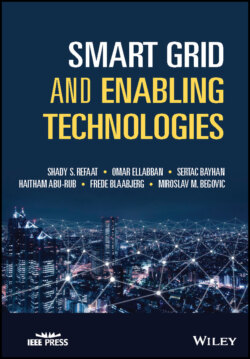Читать книгу Smart Grid and Enabling Technologies - Frede Blaabjerg - Страница 25
1.4 Smart Grid Definition
ОглавлениеThe Department of Energy (DOE) defines the SG as “the electricity delivery system, from point of generation to point of consumption, integrated with communications and information technology for enhanced grid operations, customer services, and environmental benefits” [15]. The SG implements electricity, information, and communication infrastructures to generate power more efficiently and reliably, and as cleanly and safely as possible for preserving the environment [16]. The European Technology Platform defined the SGs as “an electricity network that can intelligently integrate the actions of all users connected to it generators, consumers, to efficiently deliver sustainable, economic and secure electricity supply” [17]. From the previous definitions, it is evident that the SG is an electrical grid that entails a variety of smart technologies, operations, and measurements such as smart meters, smart appliances, renewable energy resources, electric vehicle, flexible loads, smart markers, various energy‐efficient programs, and smart end users. The SG includes the benefits of advanced communications and information technologies that provide real‐time information which can intelligently and cost‐effectively integrate the behaviors and actions of all users connected to it, i.e. generators, operators and consumers. This will ensure reliable, efficient, and economically viable solutions for the continuous delivery of clean and affordable energy. One important difference between present grids and the SG is the two‐way exchange of power and information within the grid. The conceptual model of a SG is shown in Figure 1.5 [18]. SG implements innovative products and services along with intelligent monitoring, control, communication, and processing to:
Figure 1.5 The conceptual model of SG framework. Ref [18]. Reproduced with permission from Walter de Gruyter GmbH.
Improve facilitation between the grid elements of all sizes.
Permit customers to play an important role in improving the operation of the system.
Offer customers more information and options to participate in the energy market.
Significantly decrease the environmental impact of electricity generation.
Improve the electric system efficiency, reliability, quality, and security.
Improve service quality and reduce electricity cost.
